___________________________________________________________________________
Note: I would like to share with you through these few words, photographs and hyperlinked websites, a 3 Dimensional experience as though you were actually there with us. Click on any photograph and it should enlarge to different size ….. at least half screen or size full screen. It will be clearer in detail than the photo on the post. It will be as if you were really there looking at the actual scene. You are an arm chair traveller with us.
____________________________________________________________________________
The Garden around the whole House
…. Is a series of interconnecting Garden Rooms …. The whole garden has been designed as a series of linked garden rooms. Each garden room has a different function but has created a real sense of belonging. It may not be open space but it has a sense of unity different to the next garden room …….
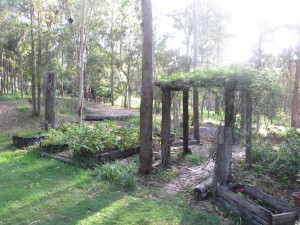
……. There is a timber gate entry into the front garden room. It has over it a native Pandorea vine that gives white tubular flowers in season. This gives a soft entry or exit from the front garden room ……..
……. To the right of the timber gate entry, is a hand-built timber planter box. I make heaps of compost in a big heap down the back from green waste, scraps, and all our thrown-out paper and cardboard. Compost is an earthy-smelling, humus-like material that is a product of the controlled aerobic decay of organic nitrogen. Bacteria break this all down into a rich black residue that holds many times its weight in water. The planter box is filled with compost. In the first year in 2013, Eucharist lilies were planted out to give large masses of white flowers in the second year = 2014, seedlings like poppies were planted in this compost. See the results below ……..
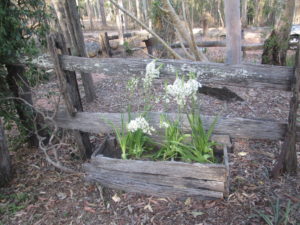
…. In the first year in 2013, Eucharist lilies were planted out to give large masses of white flowers ….
In the second year = 2014, seedlings like poppies were planted in this compost.
……. In 2015, tulips grew and flowered. In Subtropical Queensland, you do not grow tulips as it is too warm.
They like colder climates as down in Southern Australia or overseas. What we do is to trick the tulip bulbs in getting them to think they have gone through winter overseas. We put them in the fridge crisper in April / May, then we take them out and plant them in late May. They grow and flowering late August. Below is the result! …….
 ……. Tulips planted in separate pots …….
……. Tulips planted in separate pots …….
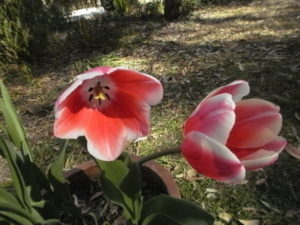
In May 2019 I Ken, planted many tulips, daffodil, and other flowering bulbs into pots in the potting area. In mid-June, they began emerging as long green leaves clustered together. Suddenly in early July, flowers began to form. One single tulip flower, daffodil, and jonquil flowers. Harriet brought them around to the front entry of our house so we could enjoy them every day and anyone coming to our house we see them and enjoy them when they visited.

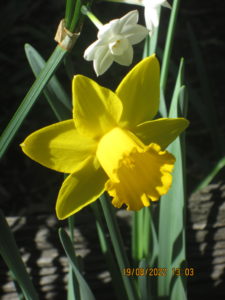
Daffodils
Daffodils represent Spring like no other bulb. They come in many different styles and shades, but yellow is their prominent colour. They are ideal for pots, tubs and spread throughout the garden. Leave in the ground year after year and the bulbs multiply. Great as a cut flower and excellent under trees, particularly deciduous trees, so they get the late Winter and early Spring sun to kick them off.
_________________________________________________________________________
.… Wisteria in flower in September 2015 ….
…. growing over an old cubby house framework I built for our two children in 1984. The framework is 37 years of age.
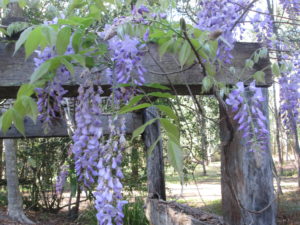
Wisteria
Wisterias climb by twining their stems either clockwise or counterclockwise around any available support. They can climb as high as 20 m (66 ft.) above the ground and spread out 10 m (33 ft.) laterally. The world’s largest known wisteria is in Sierra Madre, California, measuring more than 1 acre (0.40 ha) in size and weighing 250 tons. Planted in 1894, it is of the ‘Chinese lavender’ variety.[15]
The leaves are alternate, 15 to 35 cm long, pinnate, with 9 to 19 leaflets. The flowers are produced in pendulous racemes 10 to 80 cm long, similar to those of the genus Laburnum, but are purple, violet, pink or white. There is no yellow on the leaves. Flowering is in spring (just before or as the leaves open) in some Asian species, and in mid to late summer in the American species and W. japonica. The flowers of some species are fragrant, most notably W. sinensis. Wisteria species are used as food plants by the larvae of some Lepidoptera species including brown-tail.
The seeds are produced in pods similar to those of Laburnum, and, like the seeds of that genus, are poisonous. All parts of the plant contain a saponin called wisteria, which is toxic if ingested and may cause dizziness, confusion, speech problems, nausea, vomiting, stomach pains, diarrhea, and collapse.[16][17] There is debate over whether the concentration outside of the seeds is sufficient to cause poisoning. Wisteria seeds have caused poisoning in children and pets of many countries, producing mild to severe gastroenteritis and other effects.[18][17][19]
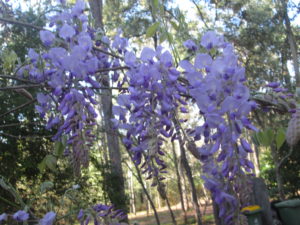
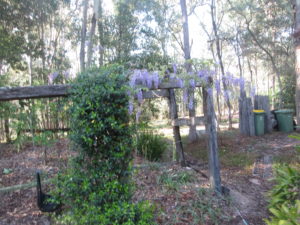
… In November 2017 ….. The profuse mass of small white flowers in the photograph below is a jasmine plant twisting and climbing up a post old cubby house framework I built for our two children in 1984.
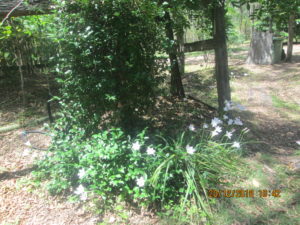
/////
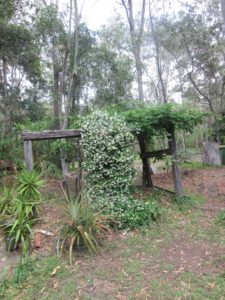
Jasmine
Jasmine can be either deciduous (leaves falling in autumn) or evergreen (green all year round), and can be erect, spreading, or climbing shrubs and vines. Their leaves are born, opposite, or alternate. They can be simple, trifoliate, or pinnate. The flowers are typically around 2.5 cm (0.98 in) in diameter. They are white or yellow in color, although in rare instances they can be slightly reddish. The flowers are borne in cymose clusters with a minimum of three flowers, though they can also be solitary on the ends of branchlets. Each flower has about four to nine petals, two locules, and one to four ovules. They have two stamens with very short filaments. The bracts are linear or ovate. The calyx is bell-shaped. They are usually very fragrant. The fruits of jasmines are berries that turn black when ripe.
The basic chromosome number of the genus is 13, and most species are diploid (2n=26). However, natural polyploidy exists, particularly in Jasminum sambac (2n=39), Jasminum flexile (2n=52), Jasminum mesnyi (2n=39), and Jasminum angustifolium (2n=52).[6]
Distribution and habitat
Jasmines are native to tropical and subtropical regions of Eurasia, Australasia, and Oceania, although only one of the 200 species is native to Europe.[7][8] Their center of diversity is in South Asia and Southeast Asia.[9]
A number of jasmine species have become naturalized in Mediterranean Europe. For example, the so-called Spanish jasmine (Jasminum grandiflorum) was originally from Iran and western South Asia, and is now naturalized in the Iberian peninsula.[6]
Jasminum fluminense (which is sometimes known by the inaccurate name “Brazilian Jasmine”) and Jasminum dichotomum (Gold Coast Jasmine) are invasive species in Hawaii and Florida.[10][11] Jasminum polyanthum, also known as White Jasmine, is an invasive weed in Australia.[12]
_________________________________________________________
See the next post: Post 3: Posts used to Create the Edges of Garden Rooms
_________________________________________________________




